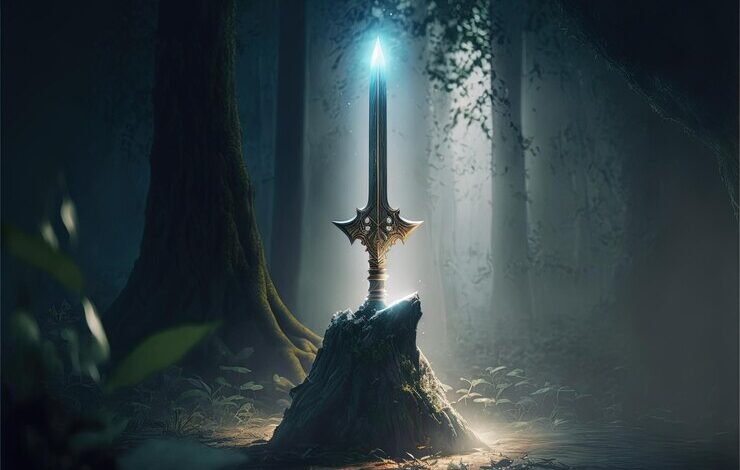The Enchanting Allure of Sword Gods in a World of Magic

Fantasy literature and gaming enthrall us with their captivating geographical regions inhabited through first-rate beings and epic battles. One such charming archetype is the Sword God in a world of magic. The fusion of unprecedented swordsmanship with effective magical skills makes the Sword God a charming man or woman, deeply liked by enthusiasts. This weblog put up unravels the appeal of the Sword God archetype, exploring its traits, importance, and impact on the fandom.
Understanding the Sword God Archetype
Definition and Characteristics of the Sword God
The Sword God archetype epitomizes the mastery of swordsmanship combined with brilliant magical prowess. These characters are regularly depicted as warriors who’ve honed their skills to near perfection, making them formidable opponents and revered heroes. They embody features such as unwavering dedication, outstanding fight talents, and a deep connection to their magical powers.
Notable Examples in Literature, Movies, and Gaming
Sword Gods have left an indelible mark on various types of media. In literature, characters like Drizzt Do’Urden from the “Forgotten Realms” collection and Rand al’Thor from “The Wheel of Time” exemplify this archetype. In movies, Aragorn from “The Lord of the Rings” and Geralt of Rivia from “The Witcher” are celebrated Sword Gods. Gaming lovers respect characters like Cloud Strife from “Final Fantasy VII” and Link from “The Legend of Zelda,” who encompass the correct combination of swordsmanship and magic.
The Intersection of Swordsmanship and Magic
Analysis of the Relationship Between Swordsmanship and Magic
The interaction among swordsmanship and magic creates a dynamic and multifaceted individual. While swordsmanship requires physical prowess, area, and approach, magic provides an detail of mysticism and strategic intensity. The combination permits Sword Gods to evolve to numerous fight situations, making them flexible and unpredictable.
How the Two Elements Complement Each Other
Swordsmanship and magic complement every different by way of enhancing the person’s talents and broadening their ability set. Magic can augment a Sword God’s physical skills, permitting feats of electricity and agility beyond human limits. Conversely, swordsmanship provides a tangible, grounded issue to their magical competencies, making their combat fashion greater relatable and tasty.
Contrasts in Character Development and Combat Styles
Despite their complementary nature, swordsmanship, and magic also can create contrasts in character improvement and fight styles. The internal warfare between counting on bodily skills as opposed to magical powers can add depth to the individual’s narrative. Additionally, the choice among wielding a sword or casting a spell can result in diverse fight strategies, retaining audiences intrigued and invested within the character’s journey.
The Hero’s Journey Sword God Edition
A Breakdown of the Classic Hero’s Journey
The conventional hero’s journey, popularized by using Joseph Campbell, involves ranges which include the call to adventure, trials, the final boon, and the go back. For a Sword God, this journey is regularly marked via rigorous schooling, confrontations with powerful adversaries, and self-discovery.
How the Sword God’s Journey Differs
The Sword God’s hero’s adventure diverges from conventional heroes because of their dual proficiency in swordsmanship and magic. Their training encompasses learning each arts, regularly underneath the steering of mentors or via historic texts. This multifaceted schooling prepares them for particular challenges, requiring each physical combat and magical answers.
Examples of Sword God Characters Embarking on Their Journey
Characters like Rand al’Thor and Geralt of Rivia exemplify the Sword God’s hero’s journey. Rand’s quest to defeat the Dark One includes mastering the One Power whilst honing his sword abilities. Geralt’s adventures in “The Witcher” series showcase his prowess in combat and magic, as he navigates a world packed with monsters and moral dilemmas.
Community and Fandom Impact
Insights into the Fandom’s Response to Sword God Characters
The Sword God archetype has garnered a devoted fanbase that passionately engages with these characters. Fans appreciate the complexity and intensity of Sword Gods, frequently celebrating their favourite characters via fan artwork, fan fiction, and discussions on boards and social media.
Notable Fan Theories and Fan Art
The innovative energy of the fandom has brought about numerous fan theories and speculations approximately Sword God characters. These theories discover ability plot twists, man or woman motivations, and hidden powers. Fan artwork brings these characters to life, depicting epic battles, serene moments, and imaginative interpretations of their abilities.
The Role of Fan Fiction in Expanding Sword God Narratives
Fan fiction plays a important function in expanding the narratives of Sword God characters. Writers inside the fandom create trade storylines, discover untold adventures, and increase romantic subplots, enriching the overall lore and offering new views on liked characters.
Crafting a Sword God Character
Tips for Writers and Game Developers
Creating a compelling Sword God individual involves balancing their swordsmanship and magical skills. Writers and game developers need to awareness on growing a wealthy backstory, highlighting the person’s education, demanding situations, and increase. It’s critical to infuse the individual with particular tendencies and motivations that set them aside from different heroes.
Balancing Skills and Weaknesses for Engaging Storytelling
A properly-rounded Sword God character ought to own each strengths and weaknesses. While their combat abilities and magical powers lead them to bold, vulnerabilities and inner conflicts upload depth and relatability. These weaknesses may want to stem from personal fears, beyond traumas, or obstacles of their skills, growing opportunities for character boom and improvement.
Engaging Gameplay Mechanics for Sword God Characters
In gaming, Sword God characters can be delivered to life through attractive gameplay mechanics. Developers can layout complex fight structures that seamlessly combine swordsmanship and magic, permitting players to exchange among the 2 patterns. Incorporating skill bushes, customizable capabilities, and dynamic combat situations can decorate the player’s revel in and immersion.
Real-World Inspiration for Sword God Stories
Historical and Cultural References
The Sword God archetype attracts concept from historical and cultural references. Figures like Miyamoto Musashi, a mythical Japanese swordsman, and Merlin, the iconic wizard of Arthurian legend, function inspirations for crafting Sword God characters. These historic and mythical figures provide a basis for wealthy narratives and true person improvement.
Examples of Real-Life Swordsmanship and Magical Practices
Real-existence swordsmanship practices, along with Kendo, HEMA (Historical European Martial Arts), and fencing, provide valuable insights into the bodily and intellectual area required for mastery. Similarly, ancient magical practices, which include alchemy, divination, and ceremonial magic, can inspire the magical competencies and rituals of Sword God characters.
Adding Depth to Character Backgrounds
Incorporating real-world factors into the backgrounds of Sword God characters adds authenticity and depth. By grounding their abilties in ancient and cultural contexts, writers and developers can create characters that resonate with audiences on a deeper level. This technique enriches the narrative and affords a feel of realism inside the fantastical world.
Conclusion
The Sword God archetype keeps to captivate audiences with its specific combo of swordsmanship and magic. These characters encompass the top of heroism, dealing with demanding situations with unwavering determination and remarkable skills. Whether in literature, movies, or gaming, Sword Gods encourage creativity, foster network engagement, and provide limitless possibilities for storytelling.


